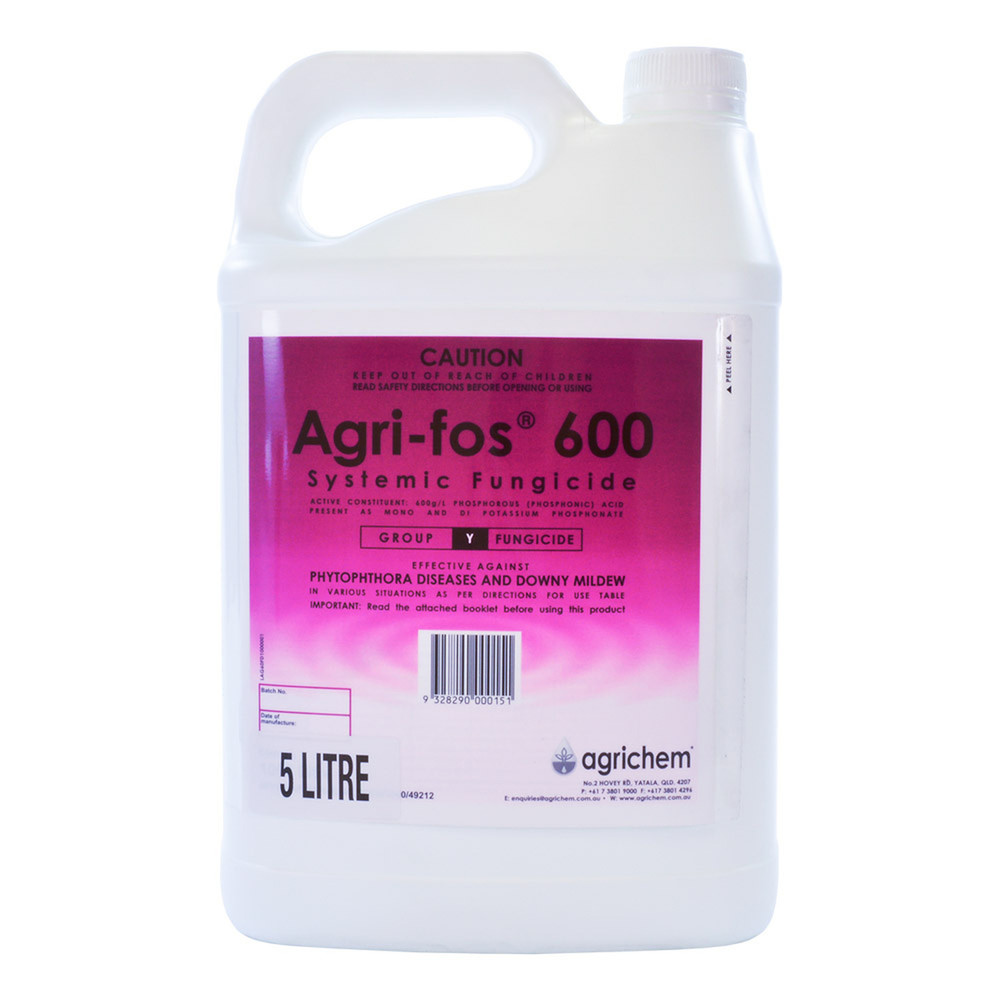Description
THIS PRODUCT: A powerful and effective buffered formulation for the control of Downy Mildew and Phytophthora diseases
Benefits of AGRI-FOS 600
- Independently tested to be on or above specification every time
- Provides effective control of Downy Mildew and Phytophthora diseases on a wide range of crops
- Formulated from a non-toxic potassium phosphite base
- Systemic action provides complete translocation throughout the plant ensuring effective disease control of all diseased plant parts
- Can be applied with a wide range of other agricultural chemicals, reducing the number of spray applications needed
- Clear liquid formulation makes it easy to decant into spray equipment and mixing tanks
- High concentration reduces quantity of product needed and saves on packaging and freight costs
Mode of Action
AGRI-FOS 600 is absorbed by the plant and translocated via the xylem and phloem to all parts of the plant. It is directly fungitoxic and enhances the plants immune system giving the plant the ability to fight the disease itself.
Disease invasion and prevention in the presence of phosphite
- Pathogen is affected by phosphite
- Suppressors either under or not produced
- Recognition of disease by plant cell
- Phosphite encourages defensive molecules, such as phytoalexins and PR proteins, to attack the disease directly; and
- Defensive molecules send “alarm signals” to cells that have not yet been attacked, then
- Polysaccharides strengthen the cell wall adding additional protection
- Disease is limited or killed by plant response
In General: A systemic fungicide is a type of fungicidal pesticide used in agriculture, horticulture, and gardening to control and prevent fungal diseases in plants. Unlike contact fungicides, which remain on the surface of plants, systemic fungicides are absorbed by the plant and translocated throughout its vascular system. This systemic action allows the fungicide to protect the entire plant, including new growth. Here’s a description of systemic fungicides and their common uses:
Description: Systemic fungicides are formulated to be absorbed by plant tissues, including leaves, stems, and roots. They are designed to move within the plant’s vascular system, distributing the fungicidal compounds to various parts of the plant. This systemic action is often achieved through specific active ingredients that have the ability to be taken up and transported by the plant.
Key characteristics of systemic fungicides include:
- Translocation: Systemic fungicides can move upward (acropetally) or downward (basipetally) within the plant, providing protection to all plant parts, including new growth.
- Residual Activity: These fungicides offer longer-lasting protection compared to contact fungicides because they are not easily washed off by rain or irrigation.
- Broad-Spectrum or Targeted: Systemic fungicides may have a broad spectrum of activity, providing control against a wide range of fungal diseases, or they may be formulated to target specific types of fungi.
- Modes of Action: They work in various ways, such as inhibiting fungal cell wall synthesis, disrupting fungal cell membranes, or interfering with fungal metabolism, depending on the active ingredient.
Uses:
- Agriculture: Systemic fungicides are used in commercial agriculture to protect crops such as grains, fruits, vegetables, and oilseeds from fungal diseases. They are particularly effective against diseases that are challenging to manage with contact fungicides alone.
- Horticulture: In horticultural settings, systemic fungicides are used to protect ornamental plants, shrubs, and trees from fungal infections. They are commonly employed in nurseries, botanical gardens, and landscaping.
- Greenhouses: Systemic fungicides are used in greenhouse operations to prevent and manage fungal diseases in controlled environments, where humidity and temperature conditions can favor disease development.
- Tree and Plant Health Care: Arborists and tree care professionals use systemic fungicides to protect and treat trees and woody plants affected by fungal pathogens, including diseases like Dutch elm disease and oak wilt.
- Gardening: Home gardeners use systemic fungicides to protect their vegetable gardens, flower beds, and ornamental plants from fungal diseases. They are particularly useful for preventive treatments.
- Crop Protection: In some cases, systemic fungicides can be applied as seed treatments or incorporated into the soil to protect crops from soilborne fungal diseases.
- Disease Control: Systemic fungicides can be used both preventively and curatively. They may be applied when diseases are already present, but preventive applications are often more effective.
- Integrated Pest Management (IPM): Systemic fungicides are an important tool in IPM programs, where they are used alongside cultural practices and biological controls to manage fungal diseases sustainably.
Overall: It’s crucial to use systemic fungicides according to label instructions, as overuse or improper application can lead to issues like resistance development in fungal populations or adverse effects on non-target organisms. Additionally, rotation with fungicides of different modes of action is recommended to delay the development of resistance in fungal pathogens.


